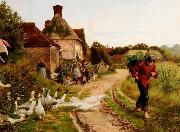Großhandels China Öl Gemälde & Rahmt Ein |
|||||||||||

|
|||||||||||
|
|
|
||||||||||||||
|
Herbert William Weekes
Herbert William Weekes (fl. 1864 - 1904) was a well-known British genre and animal painter of the Victorian Neoclassical period who specialized in portraying animals in humorous, human-like situations. Weekes was born ca. 1842 in Pimlico, London, England to a prominent artistic family: the youngest of five children, his father, Henry Weekes, Sr. (1807 - 1877), was a sculptor and Royal Academician; his brother, Henry, Jr. (fl. 1850 - 1884), was also a genre painter known for his animal studies; and his brother, Frederick (1833 - 1920), was an artist and expert on medieval costume and design. Weekes appears to have used his middle name, William, for all but formal purposes. He lived and worked for most of his life in London, at 21 Oppidans Road, Primrose Hill. In 1865, he married Caroline Anne Henshaw (born ca. 1844), of Hammersmith. "Suspicion (ca. 1900)", oil-on-canvas "Fowl Talk", oil-on-canvas Weekes' signatureKnown as an animal and genre painter of the Victorian Neoclassical style, Weekes' work was popular, and helped expand 19th century animal painting from its traditional role of simply recording beasts into a way of reflecting human life. He frequently personified animals and placed them in situations particular to humans. His work shows a sensitive understanding of his subject matter, and part of his success in capturing the peaceful country atmosphere depicted in so many of his paintings lay in his affection for it. He was greatly influenced by one of the foremost animal painters of the nineteenth century, Sir Edwin Henry Landseer. Weekes contributed illustrations for The Illustrated London News in 1883, and exhibited extensively in various London and provincial galleries. His works were well received - although not by everyone: a contemporary wit described his paintings as eWeekes' Weak Squeakse. |
||||||||||||||
|
|
||||||||||||||
|
||||||||||||||
|
|
||||||||||||||
| Herbert William Weekes
Herbert William Weekes (fl. 1864 - 1904) was a well-known British genre and animal painter of the Victorian Neoclassical period who specialized in portraying animals in humorous, human-like situations. Weekes was born ca. 1842 in Pimlico, London, England to a prominent artistic family: the youngest of five children, his father, Henry Weekes, Sr. (1807 - 1877), was a sculptor and Royal Academician; his brother, Henry, Jr. (fl. 1850 - 1884), was also a genre painter known for his animal studies; and his brother, Frederick (1833 - 1920), was an artist and expert on medieval costume and design. Weekes appears to have used his middle name, William, for all but formal purposes. He lived and worked for most of his life in London, at 21 Oppidans Road, Primrose Hill. In 1865, he married Caroline Anne Henshaw (born ca. 1844), of Hammersmith. "Suspicion (ca. 1900)", oil-on-canvas "Fowl Talk", oil-on-canvas Weekes' signatureKnown as an animal and genre painter of the Victorian Neoclassical style, Weekes' work was popular, and helped expand 19th century animal painting from its traditional role of simply recording beasts into a way of reflecting human life. He frequently personified animals and placed them in situations particular to humans. His work shows a sensitive understanding of his subject matter, and part of his success in capturing the peaceful country atmosphere depicted in so many of his paintings lay in his affection for it. He was greatly influenced by one of the foremost animal painters of the nineteenth century, Sir Edwin Henry Landseer. Weekes contributed illustrations for The Illustrated London News in 1883, and exhibited extensively in various London and provincial galleries. His works were well received - although not by everyone: a contemporary wit described his paintings as eWeekes' Weak Squeakse. Date betw 1864-1904 cyf |
||||||||||||||
|
Related Paintings to Herbert William Weekes :. |
||||||||||||||
|
|
||||||||||||||
|
|
||||||||||||||
|
KONTAKTIEREN Sie UNS |







